Inside the Thierry Mugler Exhibition at the Brooklyn Museum
- Oops!Something went wrong.Please try again later.
- Oops!Something went wrong.Please try again later.
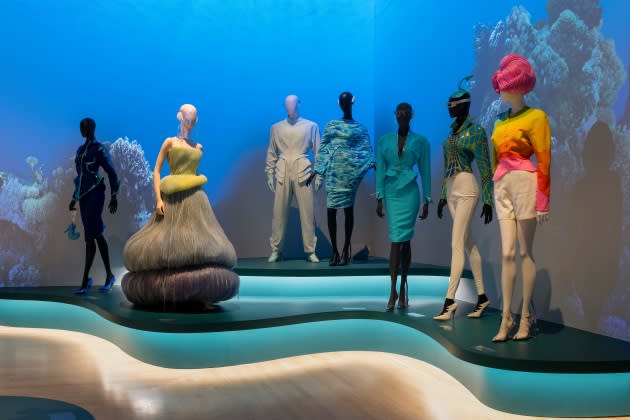
The past isn’t just the present, but it is also very much the future at the Brooklyn Museum’s new exhibition “Thierry Mugler: Couturissime.”
That message rang loud and clear, during a walk-through Monday morning with the museum’s senior curator of fashion and material culture Matthew Yokobosky, Mugler creative director Casey Cadwallader, and the head of the Mugler archives, Marion Bourdée. Enthralling and forward-thinking as the show is, it also will sound a knell, as Mugler died unexpectedly in January at the age of 73. The Brooklyn exhibition will be the final stop in a five-city tour.
More from WWD
While the decades-spanning range of 100 provocative and often incomparable ensembles amounts to a retrospective, Yokobosky sees it more as “a dramatic overview” of thematic threads that coarse through the designer’s work. Multimedia, and at one point olfactory, the exhibition, which opens to the public Friday and runs through May 7, magnifies Mugler’s zeal for theater, fantasy, movement, sci-fi, eroticism, high glamour, the natural world and above all, strength in all its beauty. The exhibition is curated by Thierry-Maxime Loriot, guest curator for the Montreal Museum of Fine Arts. The Brooklyn presentation was coordinated by Yokobosky.
Remnants of Mugler’s Strasbourg, France, upbringing and his lifelong interest in theatrical settings can be seen in the Goth-inspired opener — a life-size hologram projection made by Michel Lemieux plays up Mugler’s designs for a theatrical production of “La Tragedie de Macbeth,” that was presented by the Comédie-Française at the 1985 Festival d’Avignon. Growing up in the shadow of the Strasbourg Cathedral, which was then the tallest building in Europe, was among Mugler’s many influences. Sketches of the costumes, in various stages, are displayed on a nearby wall for those seeking closer inspection. Initially, the performers were reluctant to wear the armor-like costumes due to their weight, but Mugler convinced them that the heavier they were, the more they reflected the fragility of a character, Bourdée said.
Having first studied ballet at the age of nine and performed through his teenage years, Mugler also studied decorative arts. As the son of a doctor, Mugler understood the body’s mechanics not just as a dancer, but also through his father’s profession. That attention to anatomy is evident in the myriad of body-hugging, but non-restrictive designs on display. To realize some of the edgier pieces, Mugler discovered talent outside of fashion, as well as some within, such as the corset maker Mister Pearl. Beyond being an exceptional tailor, Mugler “created images and he didn’t just make beautiful clothes,” Yokobosky said.
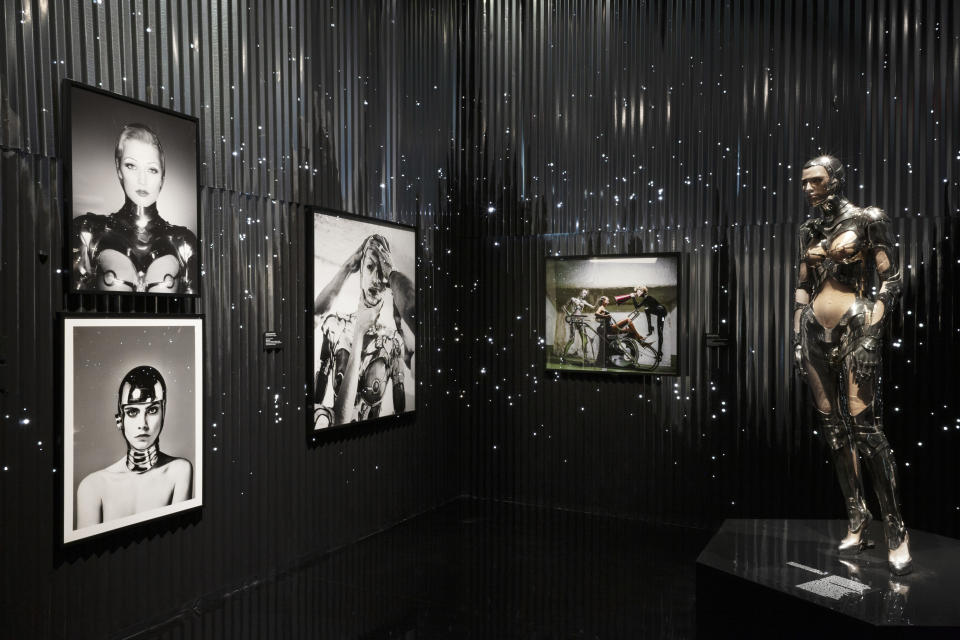
The exquisite sheer and opaque corsets that can be seen in some of the 23 Newton photographs and in more elaborate garments on display are some of the things that Cadwallader uses for inspiration for ready-to-wear and for a recent Wolford collaboration. “I’m always trying to speak new [things] to be more useful for people today,” he said.
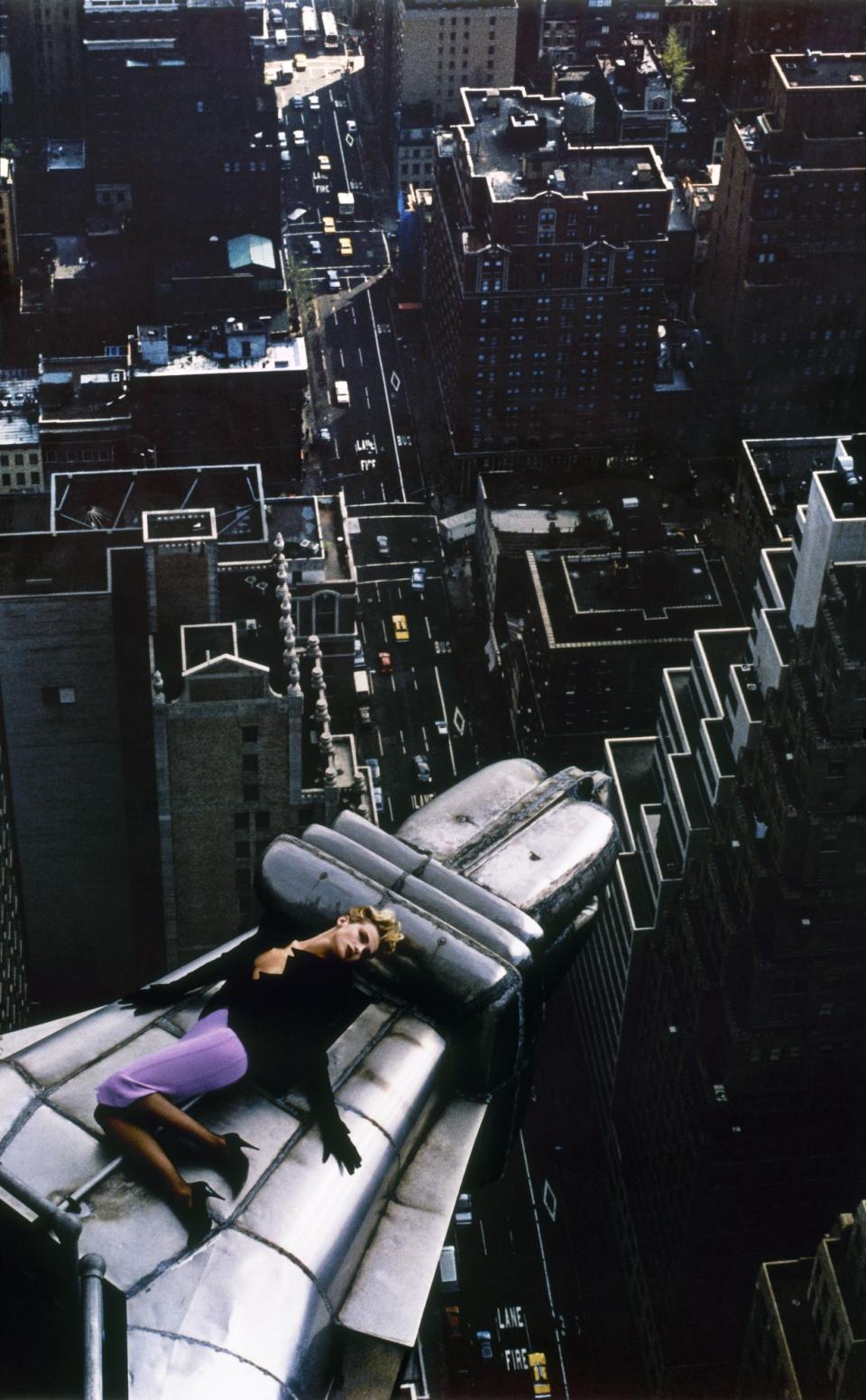
Helmut Newton, Guy Bourdin, Lillian Bassman, David LaChapelle, Sarah Moon and Herb Ritts were among the numerous sharpshooters that Mugler teamed up with. After offering Newton one too many cues on a shoot, the lensman suggested Mugler give it a go. The designer did just that by starting to shoot his own advertising campaigns, enlisting such forces as Iman, Jerry Hall, Pat Cleveland, Linda Evangelista and Naomi Campbell. One of the more death-defying ones can be seen in the framed prints of models perched on the gargoyle fixtures outdoors on the 61st floor of the Chrysler Building, a shoot that required a one-week wait for the perfect windless day. All in all, Mugler’s approach was different than “say Lagerfeld, where you feel like it’s a dress and a location. It was much more theater, where he found these notable people and architecture,” Yokobosky said.
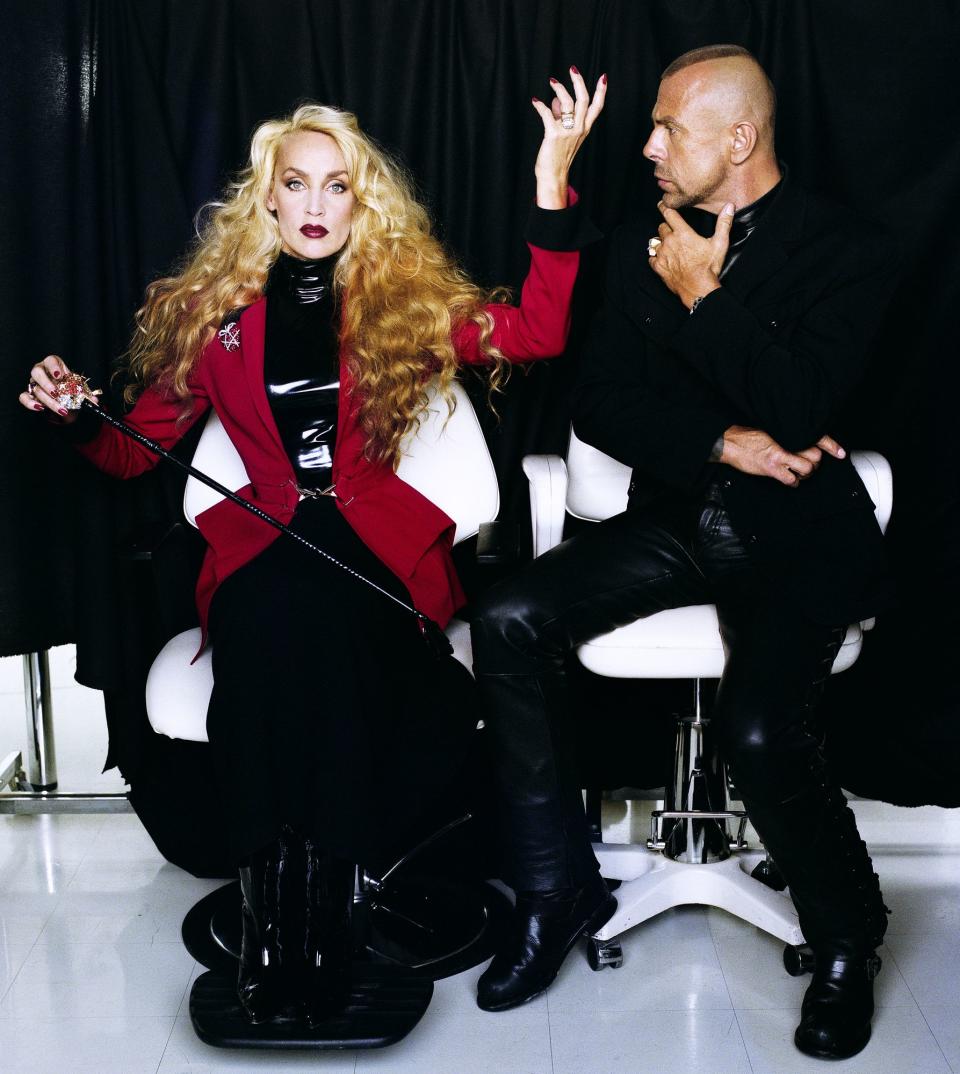
Kylie Jenner’s choice of a strapless sheer Mugler gown from the archives to wear to the CFDA Awards last week further shined the spotlight on the house. A similar dress from that collection is on view. His affinity for glamazons, fembot couture and futurism can be spotted in galleries designed by the Berlin-based artist and set designer Philipp Fürhofer.
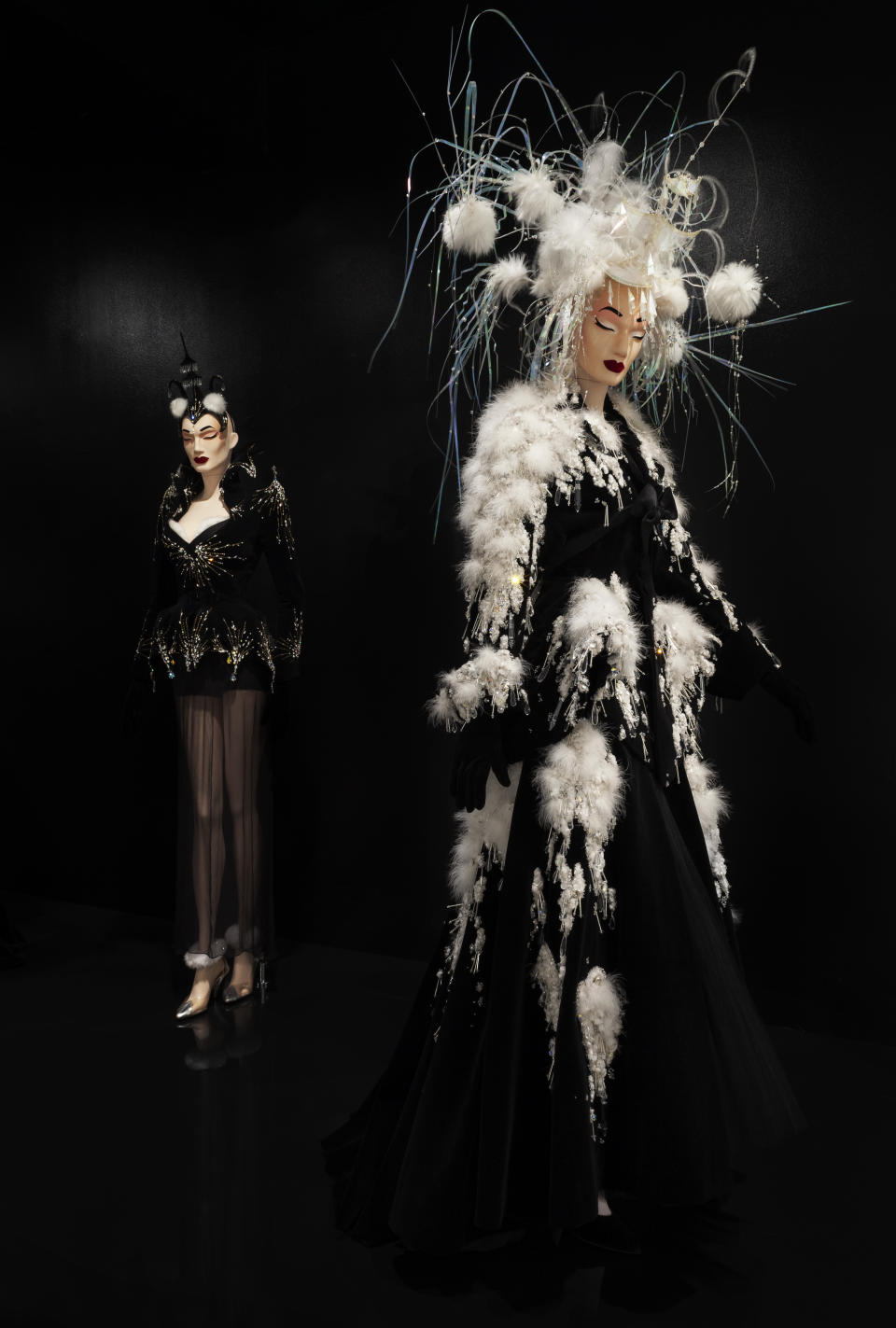
Mugler’s ahead-of-the-game leanings can be seen in George Michael’s music video “Too Funky” featuring Tyra Banks, Nadja Auermann and other leading models wearing Mugler in a fictitious runway show. Stopping in front of a breast-baring ensemble, Yokobosky said upon meeting a woman with one nipple piercing, the designer vowed to make an outfit for her if she had the other one pierced. “This was from a collection that was inspired by Jackie O. But he embraced the body in all of its forms.”
Admiring a biased black-and-white outfit and hat once worn by Lady Gaga, Yokobosky credited the Grammy winner with jump-starting modern interest in Mugler. Beyoncé soon followed, enlisting him for her “I Am…Sasha Fierce” tour, and then Lil Kim, Cardi B. and others came calling. As for the label’s lasting relevance, Cadwallader said, “It was very forward then. I think what Mr. Mugler was always doing was to be in his own dreams and out ahead of everyone else. The reason it became popular today is because it is so different. Nothing else looks like this.”
“Think about what has happened in culture since then. Now we have Instagram. Let’s say I design a dress in pink. Someone wears it and it’s [posted] on Instagram. It’s gone [crossing his arms in an ‘X’ for effect.] It’s what else? There’s this insane need for looks and new things by all the famous women in the world, who wear things once and won’t wear anything that anyone else wore. So when you’re at the top of that game, where do you start to look — places where no one can get things but you. There’s an exclusivity to be able to access and wear archives that says, ‘not only do I have the taste to find this, but I have the access to it.’ It’s an interesting way that has shined the light back into the past. It’s because things are consumed so quickly today.”
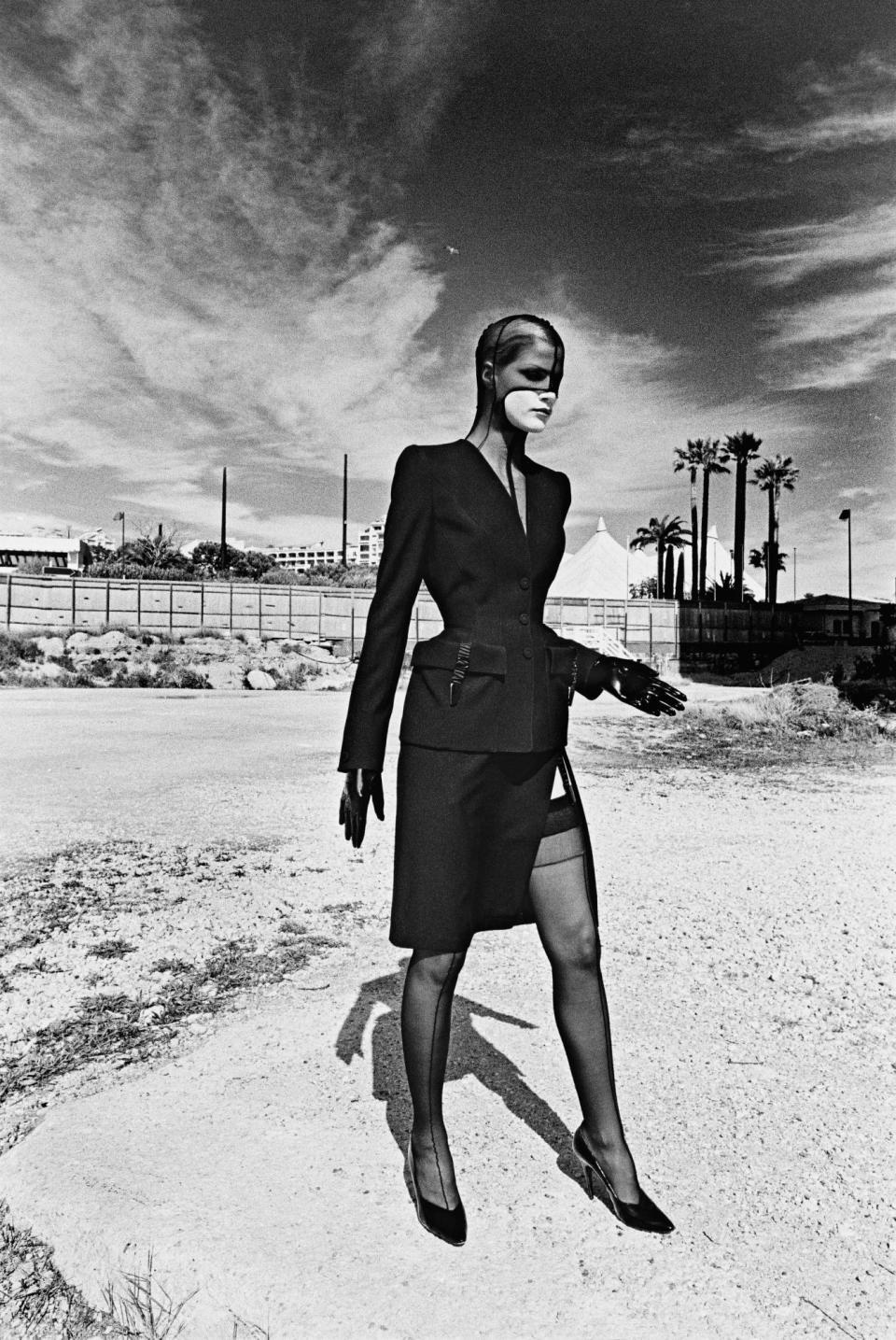
Transition was integral to much of what Mugler did, whether that be a model disrobing on the runway to reveal a complicated construction underneath the outer layer, or a pair of Helmut Newton-shot photos that have the same effect. Among the robot-inspired looks on view is one made from stainless steel and plexiglass from the mid-’90s inspired by the “Maria” character from the 1926 Fritz Lang film “Metropolis.” Familiar with those designs, Cadwallader noted how he and his team still work with Jean-Jacques Urcun, which is a source of great pride. Urcun recently made a dress for Beyoncé made from a similar chromed metal.
“I love to work with the same people, when possible. They bring not only an amazing craft, but you get to hear stories as well,” Cadwallader said. Among his favorites are ones from models, such as one told to him by a friend, who has also worked with him and recalled how a fitting with Mugler called for a 3 a.m. arrival, a two-hour wait and then Mugler made the dress from scratch at five in the morning. “She said, ‘That’s just the way it was. I said, ‘Well, we don’t do it that way,'” he recalled with a laugh. “But it was a very different time.”
Mugler’s robots glisten in the gallery, thanks to a black and steel gray backdrop twinkling with starry white light that evokes a city skyline. Visitors will also find dramatic corsets and other molded looks from Mugler’s 1989 “Buick Winter Collection” that drew inspiration from Harley J. Earl, an American automotive designer. While some designers build a career before dabbling in an automotive collaboration, Mugler did the reverse, by collaborating with the avant-garde Earl, whose signatures for General Motors included the tailfin and a concept car that evolved into the Chevrolet Corvette.
Gesturing toward a collaborative design with the aircraft specialist Jean-Pierre Delcos (who died in September), Bourdée emphasized how Mugler enjoyed working with non-fashion people to get fresh ideas “and even things that he would not have otherwise imagined were possible.” As the introductory wall text at the entrance of the exhibition spells out, Mugler wanted women to feel stronger in his clothes. To achieve that, he sought inspiration from comics, science fiction, industrial design and cars — “everything that could make people look stronger than they were,” she said.
Spectacular as many of the designs are, the installations manage to be equally evocative. Fragrance is a central to one gallery that not only showcases Mugler’s sculptural and artistic perfume bottles, but it also emits select scents including Angel, and Alien. In honor of Angel’s 30th anniversary, the strapless luminous evening gown used for the first ad campaign is on view and its enmeshed lights periodically up their wattage. A nearby case displays the print ad, perfume bottles and other keepsakes that serve as an anatomy of a photo shoot, if you will. Angel elevated the fragrance industry by incorporating ethyl maltol, a compound used in the food industry to accentuate sweetness. Another gallery houses a cabin-size glass case with mannequins seemingly in motion with coils of wires entwined at their feet, also dreamt up by the aforementioned Berlin artist. Further on in another gallery, the walls that surround “Metamorphosis” are projected with video of an insect-friendly forest. The Montreal studio Rodeo FX, which has developed special effects for “Dune,” “Game of Thrones” and “Stranger Things,” dreamt up the imagery. Any designs that resemble fur or animal skins are faux, save for a vibrant feathery butterfly-like ensemble from the ’70s that abided by restrictions of that time.
Bourdée said the last setting of the exhibition is the largest and best one. Comparing it to what the French call “écrin,” a precious little jewel box, she has been helping to finesse the installation and dressing the mannequins for the past two weeks. ”It is very touching and moving. Mr. Mugler passed away a few months ago. I am sure that the would have loved to have seen this,” she said. Always involved with every step of the process, Mugler was known to adjust the mannequins a smidgeon so that everything was just so, and Bourdée made last-minute tweaks, too. “I tried to reproduce his eye in the exhibition. I hope that he would be satisfied with my work.”
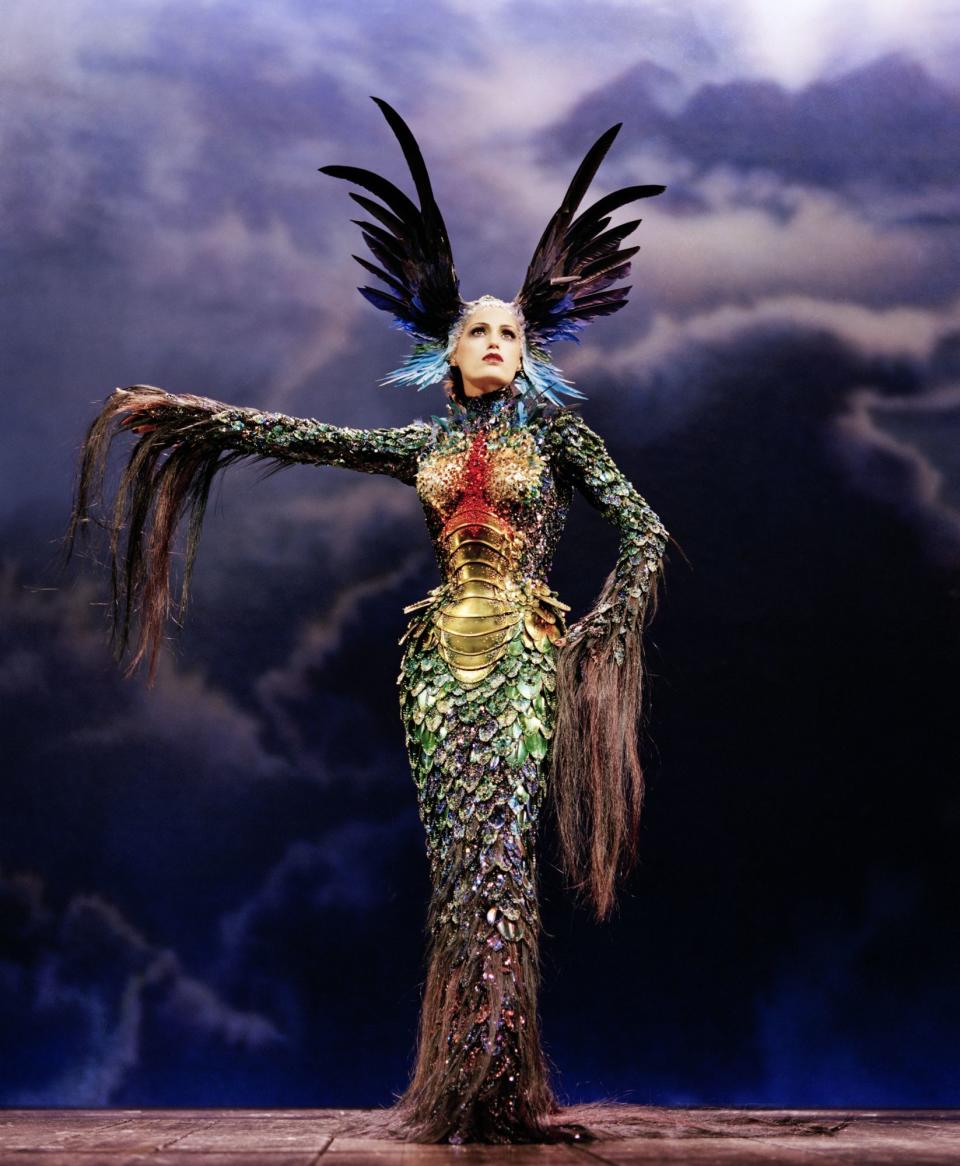
Best of WWD

